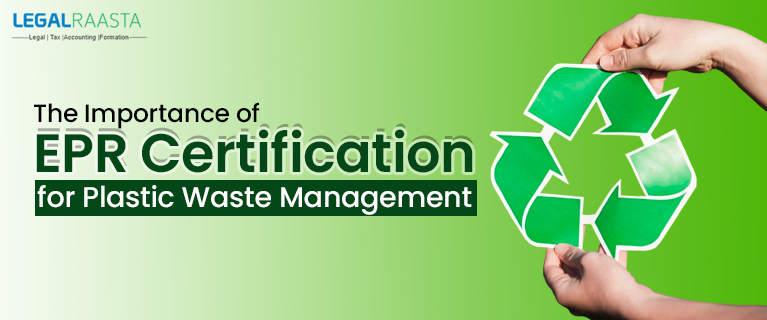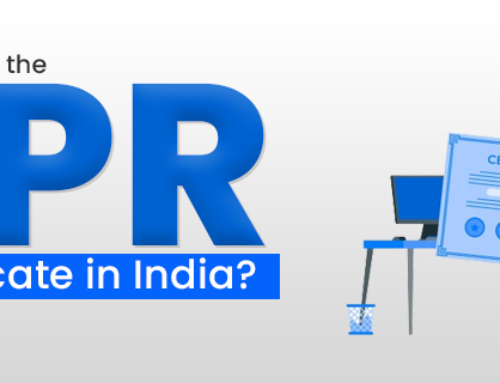In recent years, the issue of plastic pollution has gained significant attention worldwide. With the detrimental effects of plastic waste on the environment becoming increasingly evident, there has been a growing urgency to adopt sustainable solutions for its management. One such solution gaining traction is Extended Producer Responsibility (EPR) certification for plastic waste. In this blog, we’ll delve into the concept of EPR certification, its significance in addressing the plastic waste crisis, and the steps needed to obtain EPR certification.
Understanding Extended Producer Responsibility (EPR)
Extended Producer Responsibility (EPR) is a policy approach that shifts the responsibility for managing end-of-life products, including packaging materials like plastic, from consumers and municipalities to the producers. Under EPR, producers are held accountable for the entire lifecycle of their products, from design and production to disposal and recycling. This encourages producers to adopt sustainable practices and invest in waste management infrastructure.
Read Also This – How To Get EPR Certification or License in India
The Significance of EPR Certification for Plastic Waste:
Promoting Circular Economy: Extended Producer Responsibility (EPR) certification essentially shifts the responsibility for managing a product’s end-of-life waste from municipalities or consumers back to the producers. This creates a financial incentive for producers to design products that are easier to reuse, recycle, or recover. For plastics, this means designing packaging or products with materials that are more easily recyclable or compostable. By doing so, it reduces the need for virgin materials, conserves resources, and minimizes the environmental impact associated with plastic waste generation. Essentially, it encourages a shift towards a circular economy model where materials are kept in use for as long as possible, thereby reducing the overall environmental footprint.
Encouraging Innovation: When producers are financially responsible for the end-of-life management of their products, they have a strong incentive to invest in research and development to find innovative solutions. This could involve redesigning products to use fewer materials, incorporating recycled content, or developing new recycling technologies to process difficult-to-recycle plastics. EPR certification fosters a competitive environment where companies strive to outperform each other in terms of sustainability, leading to a continuous cycle of innovation. In the context of plastic waste, this innovation could lead to breakthroughs in biodegradable plastics, advanced recycling techniques, or alternative packaging materials that are more environmentally friendly.
Reducing Environmental Pollution: EPR certification ensures that producers are held accountable for the proper management of their products at the end of their life cycle. This includes implementing effective collection, recycling, and disposal systems to prevent plastic waste from ending up in the environment. Producers may invest in infrastructure to improve waste collection and sorting processes, partner with recycling facilities to ensure proper treatment of plastic waste, or even support initiatives to clean up existing pollution hotspots. By doing so, EPR certification helps to mitigate the negative impacts of plastic pollution on ecosystems, wildlife, and human health.
Fostering Corporate Accountability: By requiring producers to obtain EPR certification, regulatory bodies or industry standards organizations hold them accountable for the environmental performance of their products. This transparency helps to build trust among consumers and stakeholders who are increasingly concerned about sustainability issues. Producers are incentivized to adopt more sustainable practices, such as reducing packaging waste, using recycled materials, or supporting community recycling programs. EPR certification also encourages companies to engage with stakeholders and communicate their environmental initiatives, demonstrating a commitment to corporate responsibility and transparency. Ultimately, this fosters a culture of accountability where producers are motivated to continuously improve their environmental performance.
Steps to Obtain EPR Certification for Plastic Waste:
Assess Regulatory Requirements: Understanding the regulatory landscape is crucial for obtaining EPR certification for plastic waste. Research and review the laws, regulations, and policies governing EPR in your region. Identify the specific requirements, obligations, and deadlines established by relevant authorities. This may include regulations mandating producer responsibility for managing plastic waste, reporting requirements, and any associated fees or penalties for non-compliance. By thoroughly assessing regulatory requirements, you can ensure that your EPR initiatives are aligned with legal mandates and avoid potential compliance issues.
Engage Stakeholders: Collaboration with stakeholders is essential for developing a robust EPR plan that addresses the unique challenges and opportunities within your industry and region. Engage with key stakeholders across the plastic waste value chain, including producers, recyclers, government agencies, environmental organizations, and community groups. Solicit their input, expertise, and support to co-create a comprehensive EPR strategy that reflects diverse perspectives and interests. By fostering collaboration and inclusivity, you can enhance the effectiveness and legitimacy of your EPR initiatives and build a coalition of partners committed to sustainable plastic waste management.
Develop an EPR Plan: A well-defined EPR plan serves as a roadmap for implementing and managing your organization’s responsibilities for plastic waste. Develop a detailed plan that outlines your objectives, targets, strategies, and actions for collecting, recycling, and recovering plastic waste. Specify clear timelines, milestones, and performance indicators to track progress and measure success. Ensure that your EPR plan complies with legal requirements, industry standards, and best practices for plastic waste management. By establishing a clear and actionable plan, you can guide your organization’s efforts towards achieving its EPR goals and fulfilling its environmental responsibilities.
Implement Waste Management Systems: Implementing effective waste management systems is essential for operationalizing your EPR plan and achieving your plastic waste management objectives. Invest in infrastructure, technology, and resources to facilitate the collection, segregation, transportation, and recycling of plastic waste. Collaborate with recycling facilities, waste management partners, and other stakeholders to establish efficient and sustainable channels for managing plastic waste throughout its lifecycle. By building robust waste management systems, you can optimize resource recovery, minimize environmental impact, and contribute to a circular economy for plastics.
Read Also This – How To Get EPR Certificate For Your E waste Management
Monitor and Evaluate Performance: Continuous monitoring and evaluation are critical for assessing the effectiveness and impact of your EPR initiatives and identifying opportunities for improvement. Establish key performance indicators (KPIs) and metrics to track progress towards your EPR goals, such as waste diversion rates, recycling rates, and resource recovery outcomes. Regularly analyze data, conduct performance assessments, and solicit feedback from stakeholders to identify strengths, weaknesses, and areas for enhancement in your plastic waste management efforts. By actively monitoring and evaluating performance, you can make informed decisions, optimize resource allocation, and drive continuous improvement in your EPR program.
Seek Certification: Once you have implemented and operationalized your EPR plan, you can pursue certification from accredited certifying bodies to validate your compliance with EPR standards and guidelines. Prepare documentation, reports, and evidence demonstrating your organization’s adherence to regulatory requirements, industry best practices, and sustainability principles in managing plastic waste. Undergo a comprehensive audit conducted by certified auditors to assess your EPR program’s conformance to certification criteria and verify its effectiveness in achieving stated objectives. Upon successful completion of the certification process, you can obtain official recognition and endorsement of your organization’s commitment to responsible plastic waste management, enhancing credibility, trust, and reputation among stakeholders.
Extended Producer Responsibility (EPR) certification for plastic waste management represents a proactive and holistic approach to tackling the pressing environmental challenges posed by plastic pollution. In recent years, the detrimental impacts of plastic waste on ecosystems, wildlife, and human health have become increasingly evident, prompting urgent calls for action to address this global crisis. EPR certification offers a promising solution by shifting the responsibility for managing plastic waste from municipalities and consumers back to the producers, thereby incentivizing sustainable practices, promoting resource efficiency, and mitigating environmental pollution.
By holding producers accountable for the entire lifecycle of their products, EPR certification encourages a paradigm shift towards more sustainable and circular approaches to plastic production, consumption, and disposal. Producers are incentivized to adopt innovative strategies for product design, material selection, and waste management that minimize waste generation, maximize resource recovery, and reduce environmental impact. This can include designing products for reuse, incorporating recycled materials, optimizing packaging design, and investing in advanced recycling technologies. By embracing EPR certification, businesses can demonstrate their commitment to environmental stewardship and contribute to the transition towards a cleaner, greener future.
Read Also This – Register EPR Online for Plastic & E-Waste
The steps outlined in this blog provide a practical roadmap for businesses seeking to obtain EPR certification for plastic waste management. By assessing regulatory requirements, engaging stakeholders, developing comprehensive EPR plans, implementing effective waste management systems, monitoring performance, and seeking certification, businesses can establish robust frameworks for managing their environmental responsibilities and driving positive change. Collaboration with stakeholders across the value chain is essential for developing holistic and inclusive solutions that address the complex challenges associated with plastic pollution. By fostering partnerships with producers, recyclers, government agencies, and environmental organizations, businesses can leverage collective expertise, resources, and influence to create meaningful impact.
Furthermore, EPR certification not only benefits the environment but also offers numerous business advantages. Adopting sustainable practices can enhance brand reputation, attract environmentally conscious consumers, and drive competitive advantage in a rapidly evolving market. By reducing waste generation, optimizing resource use, and minimizing environmental risks, businesses can achieve cost savings, improve operational efficiency, and enhance long-term sustainability. Moreover, EPR certification fosters corporate accountability, transparency, and trust, strengthening relationships with stakeholders and building resilient, future-proof business models.
Conclusion:
In conclusion, EPR certification for plastic waste management empowers businesses to proactively address environmental challenges, embrace responsibility, and drive positive change towards a cleaner, greener future. By following the steps outlined in this blog and embracing the principles of sustainability, businesses can position themselves as leaders in environmental stewardship and contribute to the collective effort to safeguard our planet for generations to come. Together, we can create a world where plastic pollution is minimized, resources are used efficiently, and ecosystems thrive in harmony with human activities.






